An Owl Tour today. After yet more windy weather over the weekend, as Storm Dennis swept across the country, it was nice that conditions had improved today and we could get out looking for owls. The wind had dropped, although it got more blustery again through the day. It was dry and we even had some bright sunny periods through the morning.
After a prompt get away, we headed straight down to the marshes and before we even got out of the minibus we could see a Barn Owl out hunting over the grass by the road. It did a circuit of the field, round over the edge of the reeds and then disappeared round behind a hedge.

Walking up onto the bank, we could see another Barn Owl on a fence post down on the marshes the other side. We got the scope on it, and could see it was scanning the long grass below intently. Then it took off, hovered, and dropped sharply down into the vegetation. When it came up again, we could see it had a vole in its bill, which it quickly transferred to its talons. It made a beeline back over the grass towards the trees beyond. At this time of day, Barn Owls are often robbed of their catch and it took evasive action as a Rook flew towards it, before disappearing with its prey back into the wood.
Looking back the other side, there were now two different Barn Owls hunting the fields there. We watched them for a few minutes, until they both disappeared, presumably heading in to roost. A Kestrel flew across and landed in the top of the hedge briefly, the main prey-stealing culprit here!
The other raptors were coming out too now. Two Red Kites drifted out of the trees and across the marshes. A Common Buzzard circled up inland and flew in towards us, mobbed by two Jackdaws. A couple of Marsh Harriers were quartering the marshes in the distance. There were other things to see here as well. A small flock of Curlews were feeding in the grass around a small flood which had appeared after all the recent rains. The local mob of teenage Mute Swans had gathered round it too. A Brown Hare ran across the grass. A Song Thrush was in full song back in the trees.
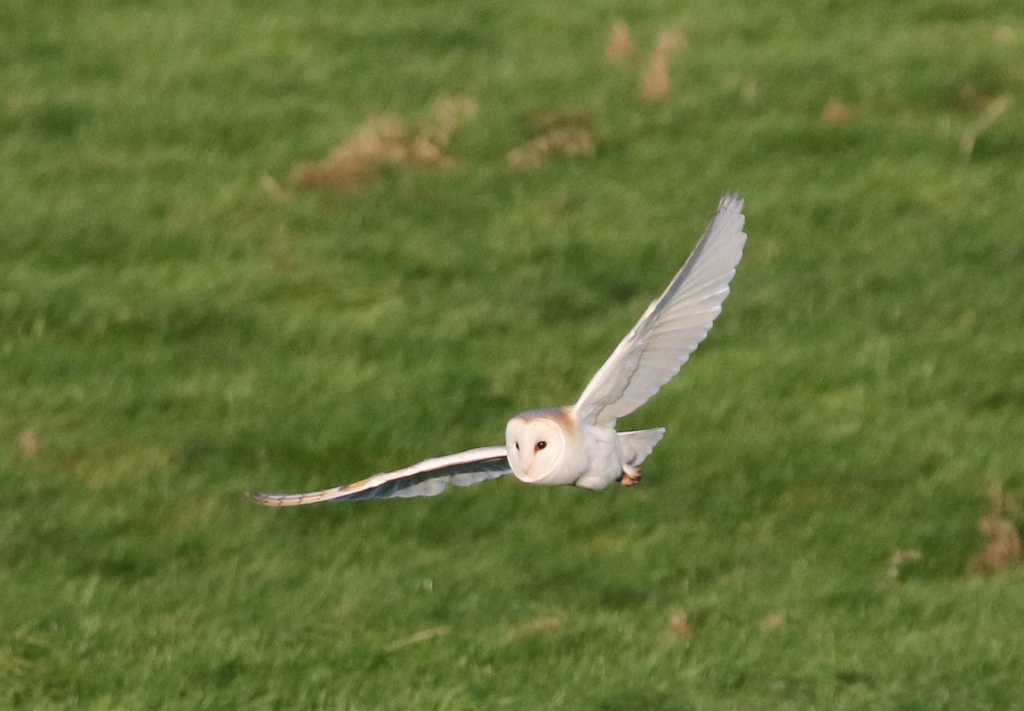
The Barn Owl we had seen catch a vole earlier now appeared out of the trees again, presumably having digested its earlier prey. With the low morning sunshine behind us, it was beautiful light as we watched it working its way methodically around the grazing marsh. It dropped down into the grass a couple of times, but didn’t catch anything more. Then it flew back and landed in the trees on the edge of the wood. It perched there for a while, sunning itself, and we watched it in the scope before it dropped down onto a fence post just below. Then it set off again, purposefully, along the edge of the grass, across the road, and then turned sharply and disappeared into the trees.
Presumably, the Barn Owl was heading into roost. It was good that we had managed an early start to catch them out hunting, as there was no sign of any of the three Barn Owls we had seen this morning. We decided to move on. We headed inland, parking on the edge of some fields before setting off down a footpath.
There were a few tits and Chaffinches in the trees, and one or two Robins in the hedges this morning. As we rounded the corner, two Mistle Thrushes flew out and off across the neighbouring field. A couple of Common Buzzards were hanging in the breeze in the sunshine.
As we got to the far side of the wood, we turned to look back along the edge. The Tawny Owl was there as usual, in a big hole in one of the trees. We got the scope on it and watched as it seemed to stare back out at us. After a while, it closed its eyes and went back to dozing. Tawny Owl may be the commonest of our regular owls but is also the most nocturnal, so it is always a privilege to see one like this in the daytime.
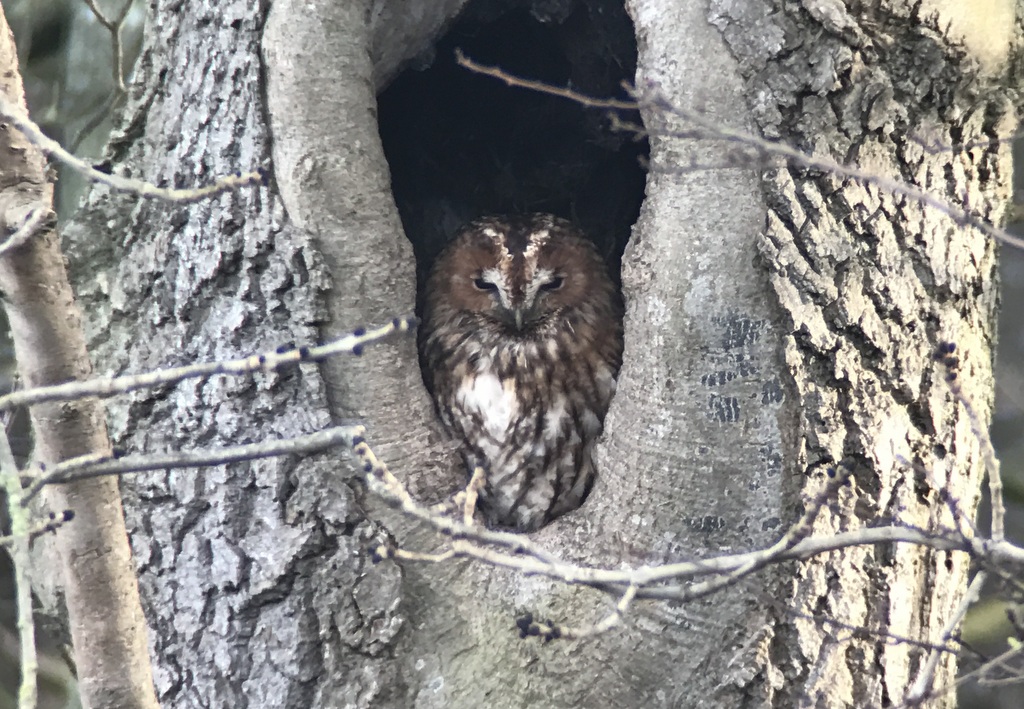
After enjoying watching the Tawny Owl for a while, we decided to move on. We headed inland to look for Little Owls next. Although the wind had dropped from recent days, there was still a rather brisk and fresh breeze, so we weren’t sure how many would be out enjoying the morning brightness today. At the first site we checked, there was no sign of any owls, but when we pulled up in a gateway overlooking the sheltered side of some barns, we could see a small round shape on the roof.
Once we got out of the minibus and set up the scope, we could see it was indeed a Little Owl, perched in a spot out of the wind and facing into the morning sun. A second Little Owl was just a few metres further down the roof, tucked in on the frame of one of the ventilation windows.
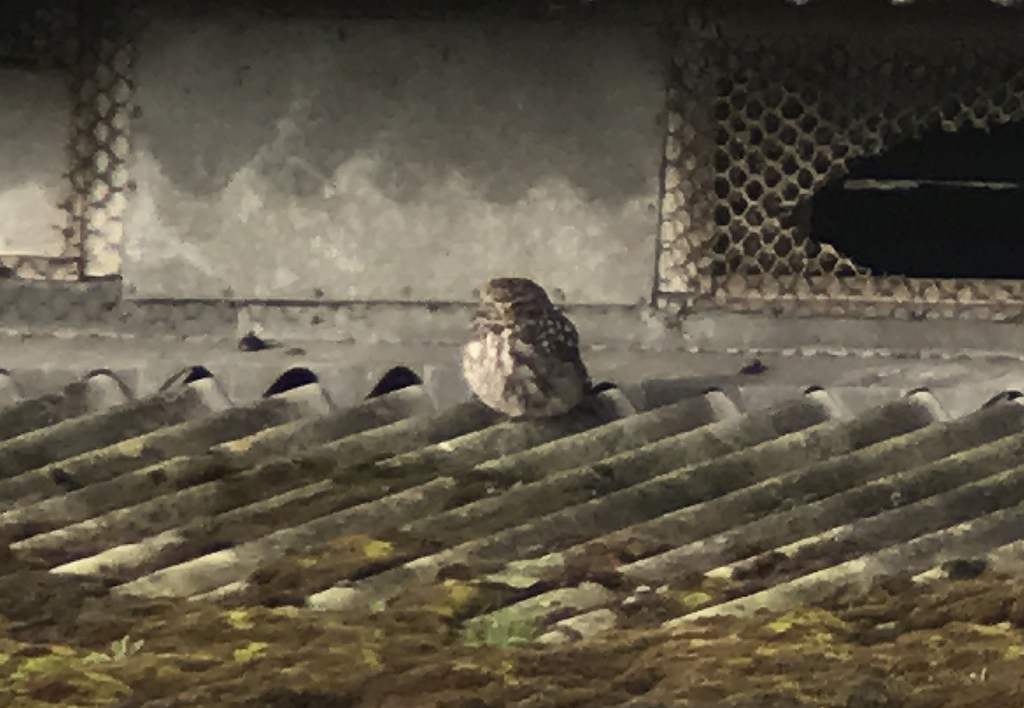
We had a look at some more barns, a little further up the road, but there were no more Little Owls out today. We were probably lucky to find the two we had seen, given the cool breeze. So we decided to switch our attention to the next owl on our target list – Short-eared Owl.
After the long drive over to the Wash, we stopped briefly to look at some Pink-footed Geese feeding in a strip of unharvested sugar beet in a field by the road down towards the beach at Snettisham. When we got out and up onto the seawall, the tide was out and a vast expanse of grey mud stretched all the way between Norfolk and Lincolnshire, visible in the distance.
When we got down towards Rotary Hide, we set up the scopes. With the tide out, most of the waders were very distant, but there was still a good scattering of Dunlin out on the mud closer to us and several Ringed Plover too. We could see a few Grey Plover and Knot plus one or two Turnstones with them, but despite having a good scan through the birds which were nearer to the shore there was no sign of the Little Stint which we have seen here on previous days. A couple of small groups of Golden Plover flew in and out. There were lots of Shelduck spread out over the mud too.
Our main target here was Short-eared Owl, so we made our way round to check-out the area where they normally like to roost. A Cetti’s Warbler was shouting periodically from the brambles as we passed. At the first set of bushes we scanned, we found one tucked in the brambles. It was dozing, and we couldn’t see its staring yellow eyes from here, but we all had a good look through the scope.
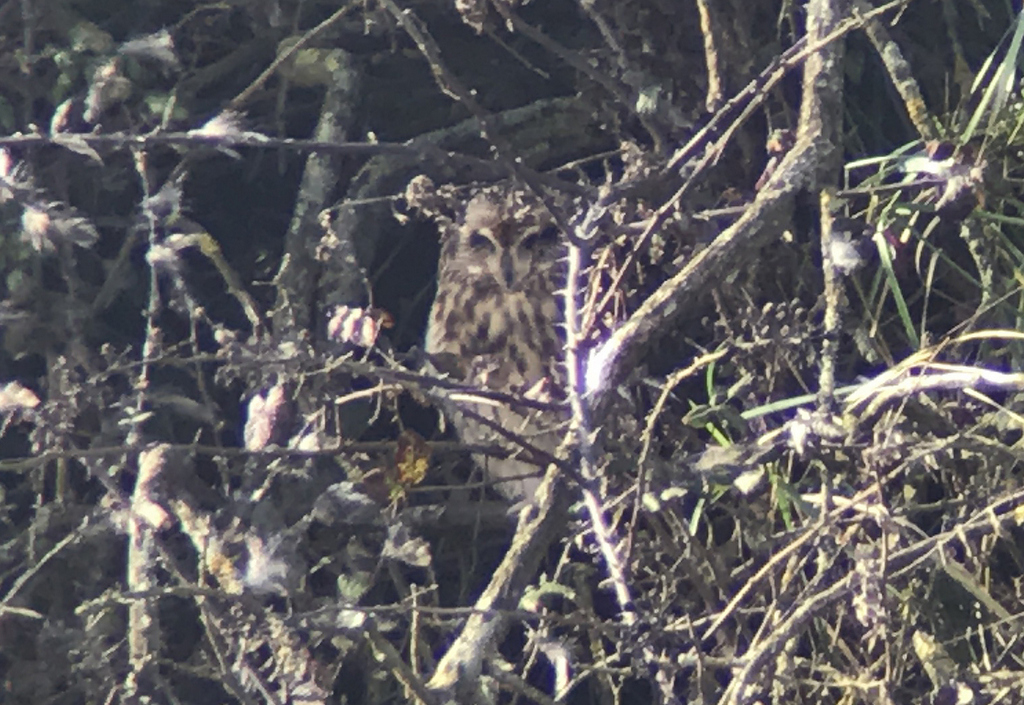
A bit further on, we stopped to scan again. We couldn’t find any other Short-eared Owls today, but we did have a different view of the first one again. Now it woke up and started preening, and we finally got a chance to see its distinctive yellow eyes, and even its short ‘ear’ tufts at one point.
There were not so many ducks on the pits at first today, but something seemed to spook lots of wildfowl from somewhere and lots flew in and landed on the water. As well as a good number of Wigeon, there were several Shoveler, one or two Gadwall and a few Tufted Ducks. We got the scope on a smart drake Goldeneye, admiring its green head, bold white cheek patch and eponymous bright golden-yellow eye. A Little Grebe was busy diving in the lee of one of the small rocky islets. When something spooked them, a large flock of noisy Greylag Geese flew in off the fields just inland.
On our way back, we stopped again to scan the mud out on the Wash. A Bar-tailed Godwit had now appeared, just beyond the channel, and there were a couple of Grey Plover and a Knot even closer, on the small pools just below us. A careful scan with the scope of the Dunlin failed to produce any sign of the Little Stint, and we were packing up when we looked away to the north and caught sight of a very small, paler wader out on the mud.
Putting the scope up again, we confirmed it was the elusive Little Stint. It was very mobile today though, in the freshening wind, and we had to keep relocating it as it got swept away several times when it took off. It was often in the company of one or two Dunlin or a Turnstone, when it certainly looked small, but it was when it ran past a Curlew that you could really appreciate just how tiny it was! One of probably just a handful of Little Stints wintering in the UK, it seems to like it here – what is probably the same bird has returned to the same area of mud for the last two winters at least. Come the spring, it will be heading off to the arctic to breed.
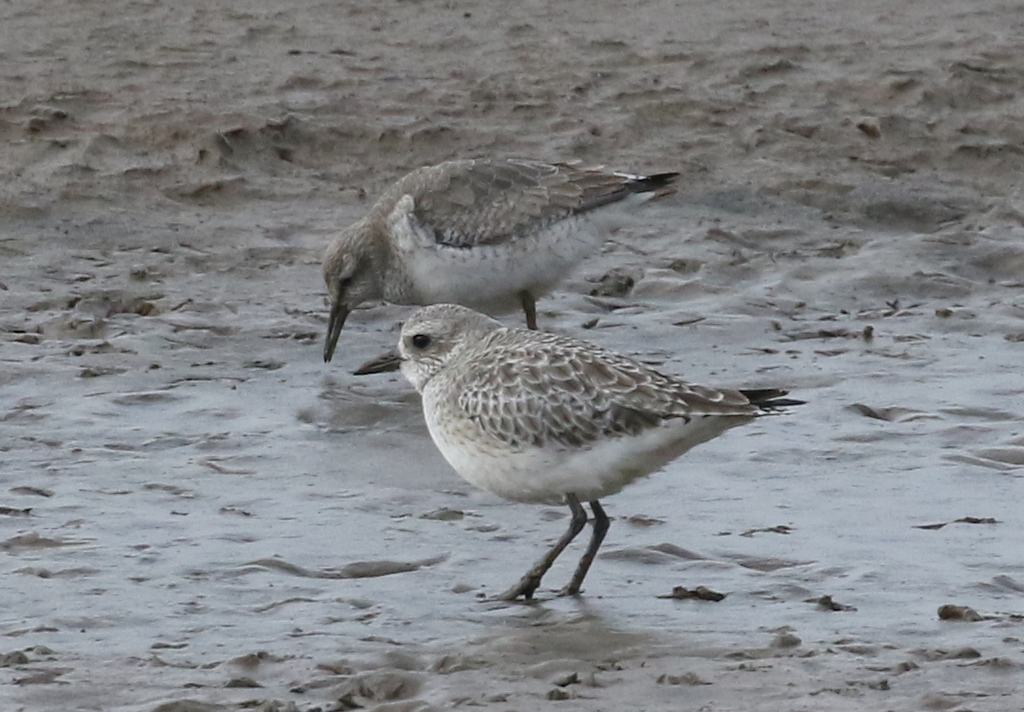
We were heading to Titchwell to have lunch, but we took a small detour inland to Sedgeford. We were hoping to catch the Eastern Yellow Wagtail here, but there was no sign of it on its currently most favoured muck heap by the road. Another birder driving back from the other muck heap down the lane opposite told us it had not been seen down there either, for several hours at least. We stopped for a minute to watch several Brown Hares chasing round in the stubble field and then continued on our way. We had lots to pack in this afternoon and unfortunately had no time to wait to see if the wagtail might reappear later.
Titchwell was surprisingly busy for midweek and mid-winter, but the picnic tables were free when we arrived so we made good use of one for lunch and a welcome hot drink. We wouldn’t have time to explore the reserve whole today, but we had planned to have a quick look to see if we could see the Woodcock. One of the volunteers coming back to the Visitor Centre told us there was no sign of it now, so we diverted instead out onto the main path, where a Barn Owl had just been seen over the grazing meadow.
The Barn Owl was down in the long grass and rushes when we arrived but after a short wait it came up again. It seemed to be struggling in the freshening wind, and again dropped down into the vegetation for a while. When it came up again, it put on a much better show for us, eventually working its way down over the grass just beyond the fence. It landed briefly on one of the fence posts but was off again almost immediately and disappeared round towards the road.
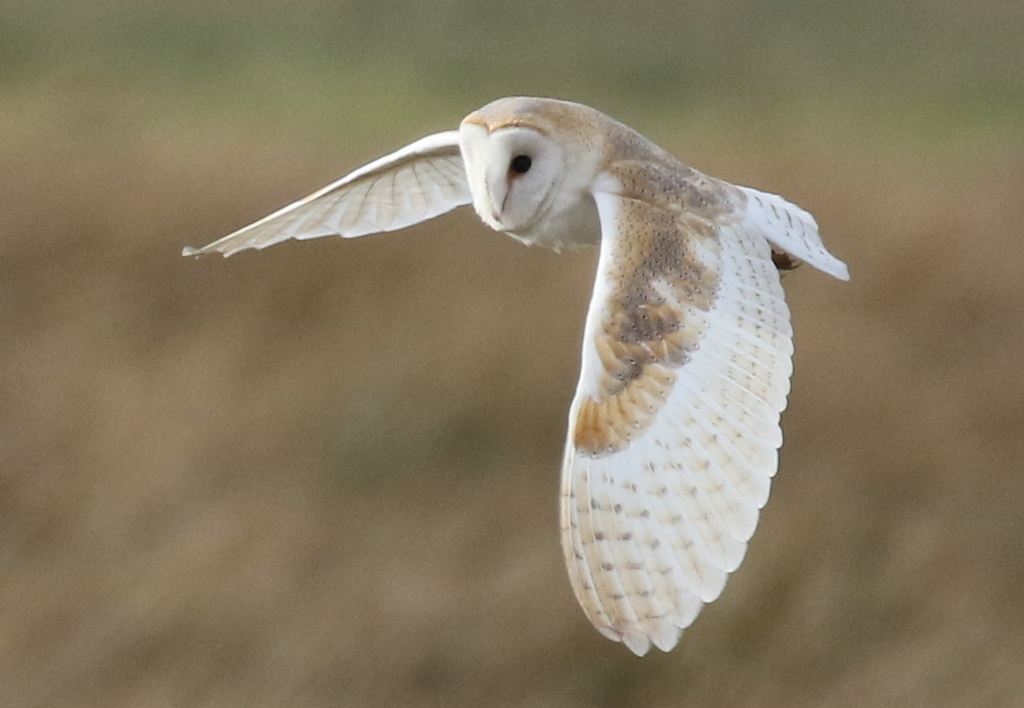

A Common Buzzard was feeding on something further back in the field while we were watching the Barn Owl, so we got that in the scope too. A second Buzzard was on a fence post just behind and several Red-legged Partridges were in the grass closer to us. When the Barn Owl disappeared, we walked on round via Meadow Trail. A small group of Long-tailed Tits was feeding in the cut branches placed on the ground in the trees. We couldn’t find any sign of the Woodcock either now, so we decided to head back to the minibus and move on. The very tame Reeve’s Muntjac was chomping on the grass where the feeders used to be, behind the Visitor Centre.
Back at Holkham, we stopped to scan the grazing marshes. A large flock of Black-tailed Godwits was whirling round out in the middle as we got out of the minibus. There were several Spoonbills on the pools today. First we found two together, busily feeding with their heads down in the water, sweeping their bills from side to side as they walked round. Three more were much further back, way off towards the pines, but flew in to join them, and a sixth Spoonbill flew out of the trees and disappeared off east.
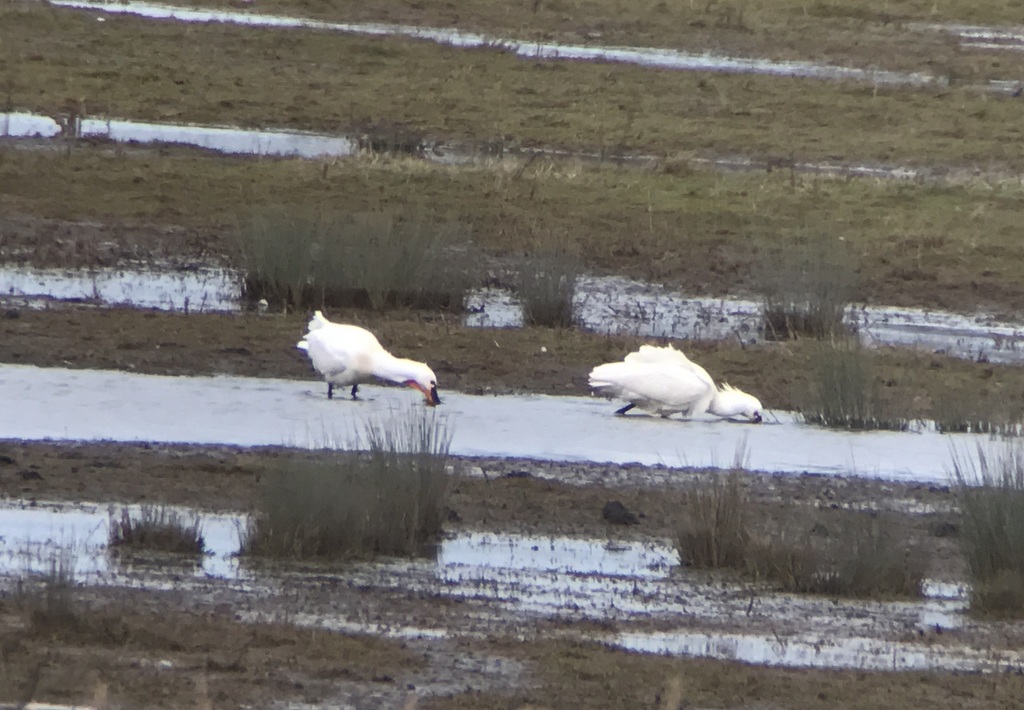
For a very large and bright white bird, the Great White Egrets made themselves surprisingly harder to find today. We eventually found one, right back in front of the pines, down in a rushy ditch where it was hard to see until it put its head up. Then if flew up, with slow and heavy wingbeats and landed again behind a sparse line of reeds. All the while, there was a second Great White Egret much closer to us, but it had managed to hide itself completely in the rushes until it eventually walked into view.
There are still quite a few lingering (Russian) White-fronted Geese at Holkham, but there were none down on the grazing marshes today. They were feeding further back, on the grass in the middle of the old Iron Age fort, and we could just see a few of them over the rim of the grassy bank. We thought we might find another Barn Owl or two out hunting here, but there were none out this afternoon.
Our next stop was at Wells. There was no sign of the Rough-legged Buzzard on its usual bushes when we arrived. We got out of the minibus and set off down the track towards the bank and we hadn’t gone too far before the Rough-legged Buzzard flew back in. It looked like it would land straight away, but instead flew on, up over the fields towards the Freeman Street car park, flushing all the Brent Geese. It was strikingly pale and, as it turned, we could see its bright white tail with broad black terminal band. It even stopped to hover at one point, rather like an over-sized, slow-motion Kestrel!

After flying round for a few minutes, the Rough-legged Buzzard returned to its normal bushes and landed on the top of one of them. Now, we could get a better look at it through the scope – its very pale white head and neck contrasting with the dark blackish belly patch. It was hard to see its feathered legs though, through the leaves and branches.
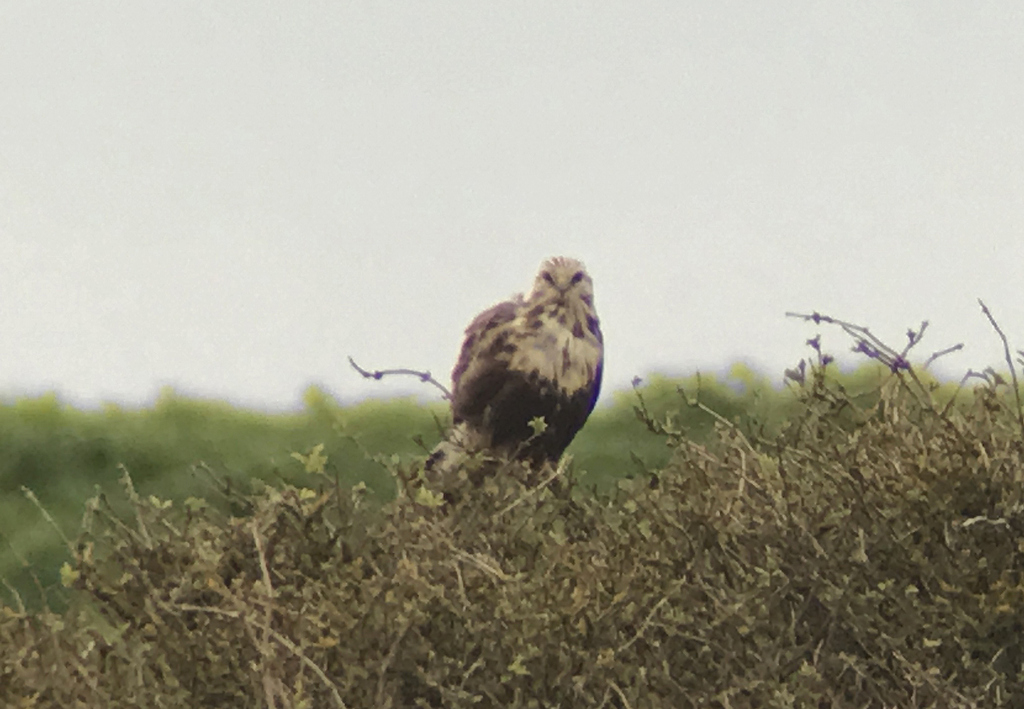
We continued on to the bank and stopped to scan the marshes beyond. There were a few Pink-footed Geese out on the grass and we got them in the scope, noting their dark heads and delicate, mostly dark bills. A passing farmer in a truck seemed like he would have preferred to run us over, although unfortunately we had all stepped to the side to let him pass, and when he drove out across the fields in the distance, he flushed a lot more Pink-footed Geese from over towards the pines. This can be a good place for owls in the late afternoon, but we couldn’t see any here today. It had clouded over progressively though and was no rather grey and cool in the strengthening breeze.
We cut back inland for one last stop on our way back. As we walked down the footpath across the meadow, two more Red Kites and a Common Buzzard hung in the air above the hillside behind us. There was no sign of the regular Barn Owl here this evening – it wasn’t out hunting and we couldn’t see it around the box where it likes to roost either. We were rather later than normal though, so it was hard to tell whether it had already gone off further afield, or was in no hurry to come out tonight given the weather.
We had a quick listen in the trees, but there were no Tawny Owls hooting yet. It is increasingly late before it gets properly dark now, and with the wind and threat of rain approaching, we decided to call it a night and not hang on any longer. Having enjoyed such great views of the Tawny Owl earlier this morning, and four different Barn Owls out hunting, not to mention the Little Owls and Short-eared Owl, we did not feel like we were short of owls today
















